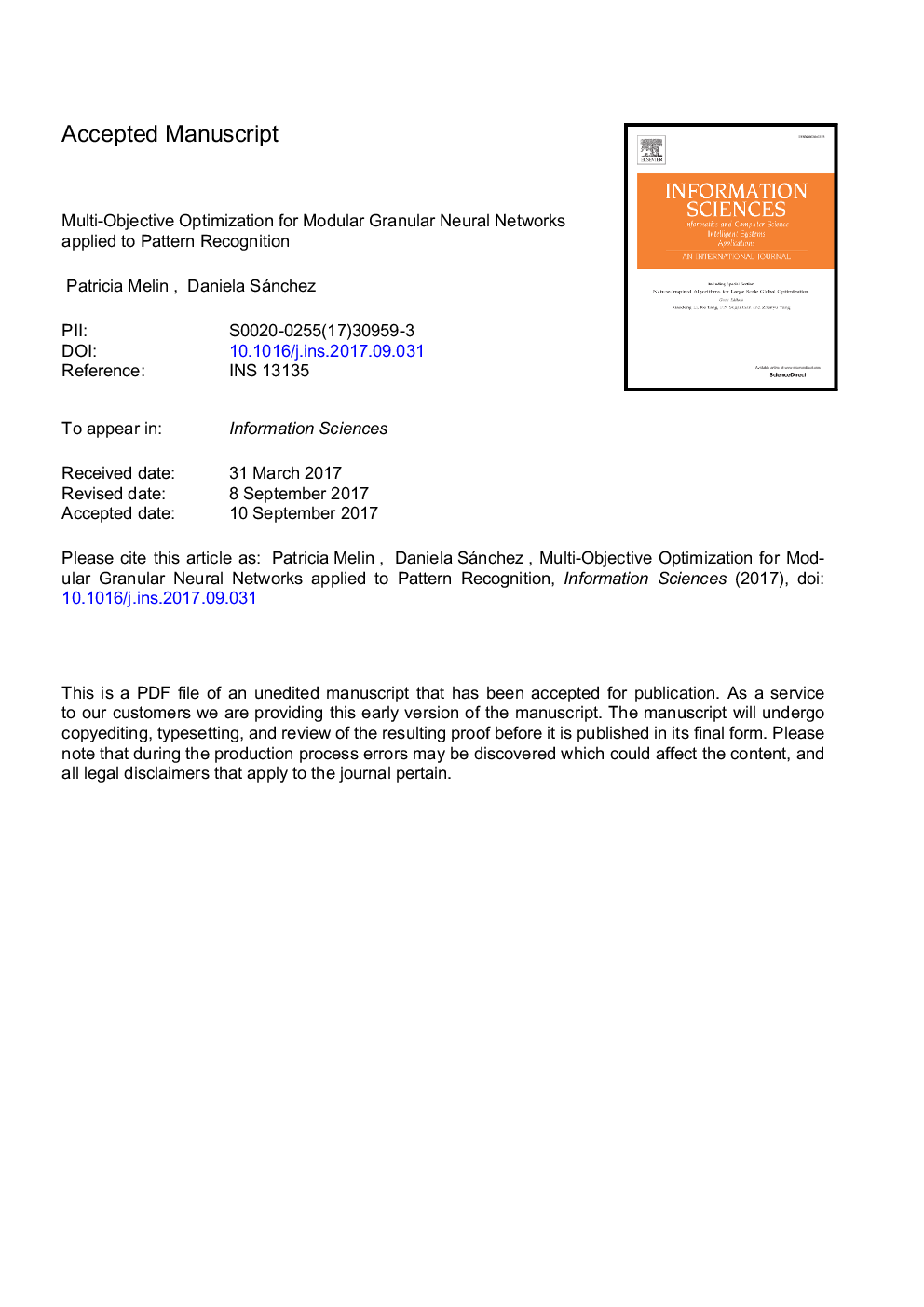| کد مقاله | کد نشریه | سال انتشار | مقاله انگلیسی | نسخه تمام متن |
|---|---|---|---|---|
| 6856312 | 1437951 | 2018 | 40 صفحه PDF | دانلود رایگان |
عنوان انگلیسی مقاله ISI
Multi-objective optimization for modular granular neural networks applied to pattern recognition
ترجمه فارسی عنوان
بهینه سازی چند هدفه برای شبکه های عصبی گرانشی مدولار اعمال شده به شناخت الگو
دانلود مقاله + سفارش ترجمه
دانلود مقاله ISI انگلیسی
رایگان برای ایرانیان
کلمات کلیدی
شبکه عصبی مدولار، محاسبات گرانول، الگوریتم ژنتیک سلسله مراتبی، شناخت انسان، بهینه سازی چند هدفه، تشخیص الگو، تشخیص چهره، تشخیص گوش،
Hierarchical genetic algorithm - الگوریتم ژنتیک سلسله مراتبیPattern recognition - بازشناخت الگوMulti-objective optimization - بهینه سازی چند هدفهFace recognition - تشخیص چهرهEar recognition - تشخیص گوشModular neural networks - شبکه عصبی مدولارHuman recognition - شناخت انسانGranular computing - محاسبات دانهای یا محاسبات گرانول
ترجمه چکیده
روش جدیدی برای بهینه سازی شبکه عصبی مدولار مبتنی بر الگوریتم ژنتیک چند منظوره سلسله مراتبی در این مقاله ارائه شده است. شبکه عصبی ماژولار با استفاده از رویکرد دانه ای و بهینه سازی آن با استفاده از یک الگوریتم ژنتیک چند منظوره سلسله مراتبی، نتایج بهترتری را نسبت به زمانی که شبکه عصبی مدولار بدون استفاده از روش گرانولی و بهینه سازی پارامترها به کار می رود، فراهم می کند. بهینه سازی پارامترهای مختلف معماری شبکه گرانشی شبکه عصبی مانند تعدادی از ماژول ها (زیر گرانول ها)، اندازه مجموعه داده ها برای فاز آموزش، خطای هدف، الگوریتم یادگیری، تعداد لایه های پنهان و تعداد مربوط به آنها در روش پیشنهادی انجام می شود. تابع تناسب اندام هدف را به حداقل رساندن اندازه مجموعه داده ها برای مرحله آموزش و خطا با استفاده از یک رویکرد چند هدف. این روش را می توان در زمینه های مختلف کاربرد، مانند شناخت انسان، مشکلات طبقه بندی یا پیش بینی سری ها استفاده کرد. در این حالت، روش پیشنهادی با شناخت انسان براساس اندازه گیری های بیومتریک صورت و گوش مورد آزمایش قرار می گیرد، در حالیکه روش پیشنهادی به دنبال یافتن راه حل های غلط بر اساس تعداد امتیازات داده شده برای آموزش و خطای شناخت است. پایه و اساس پایگاه داده های صورت و گوش برای نشان دادن مزایای رویکرد پیشنهادی استفاده می شود.
موضوعات مرتبط
مهندسی و علوم پایه
مهندسی کامپیوتر
هوش مصنوعی
چکیده انگلیسی
A new method for Modular Neural Network optimization based on a Multi-objective Hierarchical Genetic Algorithm is proposed in this paper. The modular neural network using a granular approach and its optimization using a multi-objective hierarchical genetic algorithm provides better results than when the modular neural network is applied without a granular approach and optimization of parameters. The optimization of different parameters of the modular granular neural network architecture, such as the number of modules (sub-granules), size of the dataset for the training phase, goal error, learning algorithm, number of hidden layers and their respective number of neurons are performed in the proposed method. The fitness functions aim at minimizing the size of the dataset for the training phase and the error using a multi-objective approach. This method can be used in different areas of application, such as human recognition, classification problems or time series prediction. In this case the proposed method is tested with human recognition based on the face and ear biometric measures, where the proposed method aims at finding non-dominated solutions based on the number of data points for training and the recognition error. Benchmark face and ear databases are used to illustrate the advantages of the proposed approach.
ناشر
Database: Elsevier - ScienceDirect (ساینس دایرکت)
Journal: Information Sciences - Volumes 460â461, September 2018, Pages 594-610
Journal: Information Sciences - Volumes 460â461, September 2018, Pages 594-610
نویسندگان
Patricia Melin, Daniela Sánchez,
